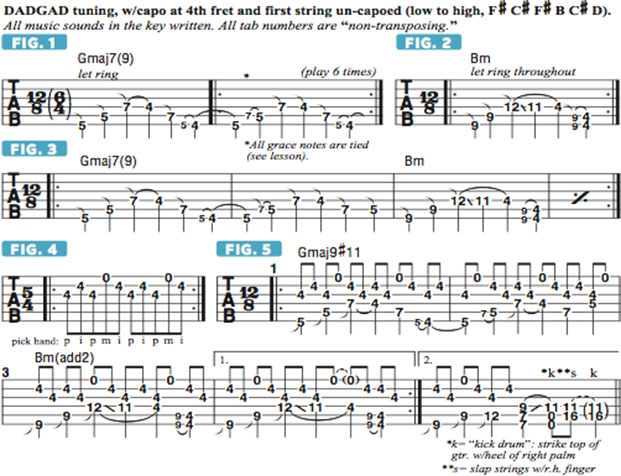Utilizing Two-Handed Polyrhythms for Solo Guitar Performance

In my experience, everyone loves a good polyrhythm, especially within the context of a solo guitar piece. Polyrhythms can add an interesting perspective and atmosphere to a piece of music, and I take quite a lot of liberties with the concept of polyrhythms on all of the songs on my What Just Happened album, as well as my new album, which will be released at the end of this year.
The examples in this column are derived from my song “The Impossible,” about which I have received many questions during clinics.
“Poly” means “more than one,” so, combined with the word “rhythm,” a polyrhythm is a musical figure in which more than one rhythmic pattern is happening simultaneously. When stacking polyrhythmic figures, an array of different and somewhat random-sounding harmonies can be created until the two different rhythms re-synchronize at a given point. In our featured example, we have a lower part performed entirely with the fret hand on the three lowest strings and a higher part on the top three strings, executed with the pick hand only. Let’s look at each part individually, then we’ll join them together.
For this song, my guitar is tuned to DADGAD (low to high: D A D G A D), with a capo placed at the fourth fret but not touching the highest string, which remains un-capo-ed. The resultant tuning, at concert pitch, is F# C# F# B C# D, which yields a very unusual chord, Fssus4addf6. Due to the use of a “partial capo” here, the tab numbers in this lesson will represent the actual frets, so a “4” on the one of the capo-ed strings would be played “open.”
Let’s begin with the fret-hand pattern, shown in FIGURE 1. The part is in 12/8 meter and may alternatively be thought of as being in 6/4, due to the use of successive quarter notes. All notes are sounded by either hammering onto a string or by pulling off from a previously fretted note, which is the case with every grace note, which is “tied” to that same note previously played.
The first three notes are sounded by hammering on “from nowhere” to the fifth fret on the sixth and fifth strings and to the fourth string’s seventh fret. I then pull off to the capo-ed “open” fourth string (the fourth fret), hammer onto the fifth string’s seventh fret and then end the pattern with the pull-off to the open sixth string. The second time the pattern is played, in bar 2, the second note is sounded with a grace-note pull-off from the seventh fret (tied from bar 1) to the fifth fret on the fifth string.
FIGURE 2 shows the next fret-hand pattern, which is performed in a very similar manner but with a few variations: after hammering on the third note, I slide back one fret and then pull off to the open string (the fourth fret). The figure ends with a double-stop pull-off on the bottom two strings, with the “tied” ninth-fret notes pulling off to the open strings. Let’s now practice moving between these two figures, as shown in FIGURE 3.
The polyrhythm now comes into play with the inclusion of the pick-hand motif, which by itself is played in 5/4 meter and is based on the repeating five-note sequence illustrated in FIGURE 4. The picking pattern for the sequence is thumb index thumb middle index (as indicated in the music by the traditional Spanish abbreviations p i p m i). All of the notes are played “open,” with the capo “fretting” the notes at the fourth fret on the second and third strings. Practice fingerpicking the sequence repeatedly until you can play it instinctively; you will need to be able to play it nearly unconsciously when combining it with the fret-hand part.
FIGURE 5 presents the two parts played together. Notice that, when the pick-hand pattern is laid over the 12/8 meter, it lines up over a downbeat every five beats, creating an unusual and seemingly random rhythmic and melodic effect. After the first four bars are played, bars 1–3 are repeated, followed by a second ending (the final bar), wherein, on beat four, I strum an Asus2 chord, and then create a “kick drum” sound by hitting the face of the guitar with my pick-hand palm. I follow this with a slap on the fifth string at the 16th fret, creating a harmonic that is played in tandem with the fretted note on the fourth string. The figure ends with another “kick.”

Mike Dawes is an English guitarist and touring musician, hailed as one of the world's most creative fingerstyle performers and renowned for his ability to seamlessly replicate a full band on a single instrument. For more information, visit mikedawes.co.uk.
Get The Pick Newsletter
All the latest guitar news, interviews, lessons, reviews, deals and more, direct to your inbox!
“There are so many sounds to be discovered when you get away from using a pick”: Jared James Nichols shows you how to add “snap, crackle and pop” to your playing with banjo rolls and string snaps
Don't let chord inversions bamboozle you. It's simply the case of shuffling the notes around







![Joe Bonamassa [left] wears a deep blue suit and polka-dotted shirt and plays his green refin Strat; the late Irish blues legend Rory Gallagher [right] screams and inflicts some punishment on his heavily worn number one Stratocaster.](https://cdn.mos.cms.futurecdn.net/cw28h7UBcTVfTLs7p7eiLe.jpg)


